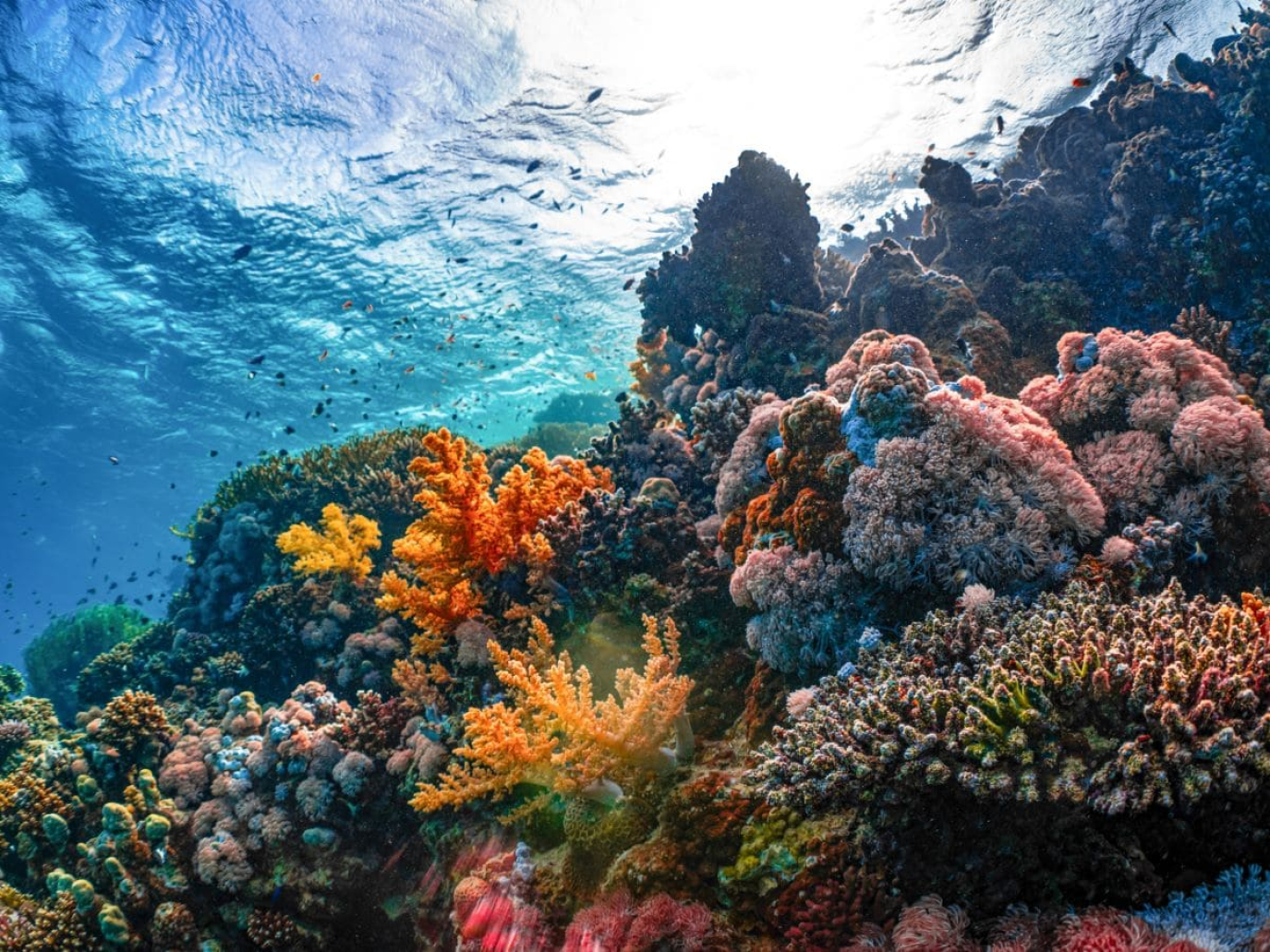This article is also avilable in Italian / Questo articolo è disponibile anche in italiano
Coral reefs, often described as the “rainforests of the sea,” are critical to marine biodiversity and the livelihoods of hundreds of millions of people. They cover less than 0.1% of the ocean floor, yet they host more than 25% of all marine species and provide ecosystem services valued at hundreds of billions of dollars annually. Despite their ecological and economic importance, the latest Annual Summary Report of Coral Reef Condition 2024–25 documents a continued pattern of decline, with large-scale bleaching events, disease outbreaks, and anthropogenic pressures accelerating reef degradation worldwide.
This is confirmed by the latest Annual Summary Report of Coral Reef Condition 2024/25, published on 6 August by the Australian Institute of Marine Science (AIMS), that paint a stark picture: coral reefs are under unprecedented stress, with average global coral cover declining by more than 17% in just over a decade and localized losses far higher.
Yet the report also identifies cases of resilience and effective management, reminding us that the trajectory of coral reefs is not predetermined. The fate of these ecosystems depends on choices made in the coming years. Rapid emissions reduction, coupled with targeted local conservation and restoration, could preserve substantial reef areas and the livelihoods they support. Delay, however, will narrow this window of opportunity and consign large portions of the world’s coral reefs to ecological and functional collapse.
A Global Overview of Reef Health
The 2024–2025 report synthesizes monitoring data from over 70 countries, assessing reef condition through live coral cover, algal dominance, fish biomass, and resilience indicators. The global average of live hard coral cover has fallen to 27.1% in 2024, compared with 32.8% in 2010. This represents a relative decline of 17.3% over 14 years. In some regions, such as the Caribbean, losses have been even more dramatic: average coral cover there now stands at 16.5%, less than half the levels recorded in the 1970s.
The Indo-Pacific, home to the most extensive reef systems, shows mixed trends. While countries such as Indonesia and Papua New Guinea still host reefs with more than 35% live coral cover, Australia’s Great Barrier Reef has suffered its sixth mass bleaching event in just nine years, reducing coral cover to below 25% in several northern and central sections. The report underscores that recurrent thermal stress events are no longer anomalies but structural drivers of ecosystem change and remain the most significant driver of coral decline. During the 2023–24 El Niño event, for example, sea surface temperatures exceeded historical averages by 1.5–2.0°C in vast parts of the Pacific and Indian Oceans.
Bleaching Events
The report documents bleaching affecting 54% of monitored reef sites worldwide. Mortality was particularly severe in parts of the Western Indian Ocean, where coral loss exceeded 40% in certain areas of Madagascar and the Seychelles.
Scientific surveys confirm that bleaching thresholds are being crossed more frequently. In the 1980s, mass bleaching events occurred roughly once every 25–30 years. Today, some reefs face severe bleaching every five years or less. This reduction in recovery time compromises the ability of coral communities to regenerate.
Even in regions with relatively low anthropogenic stress, such as parts of the central Pacific, coral species diversity has declined by more than 20% over the past two decades.
Disease, Pollution, and Overfishing
While climate change is the dominant threat, local stressors amplify vulnerability. The report highlights the rapid spread of coral diseases, particularly “stony coral tissue loss disease,” which has devastated Caribbean reefs. Between 2018 and 2024, affected sites lost an average of 45% of their remaining hard coral cover, with species such as Dendrogyra cylindrus approaching functional extinction.
Nutrient pollution also remains a critical concern. Coastal development, agricultural runoff, and untreated wastewater drive algal blooms that compete with corals for space and light. In the Red Sea, monitoring stations recorded nitrogen concentrations exceeding safe thresholds by more than 60%, correlating with localized declines in coral cover to below 20%.
Then, overfishing compounds these pressures by removing herbivorous fish populations that naturally control algae, further tipping the balance away from coral dominance.
Signs of Resilience and Local Success Stories
Despite the global decline, the report emphasizes that coral reefs are not uniformly collapsing. Pockets of resilience provide valuable lessons. In the Maldives, strict marine protected areas and active restoration projects have stabilized coral cover at around 32%, with some sites showing annual growth rates of 3–4%. Similarly, in parts of Fiji, community-led no-take zones have enabled fish biomass to double within a decade, enhancing reef recovery capacity after bleaching events.
Technological innovations are also making a difference. Assisted evolution projects, including selective breeding for heat-tolerant coral genotypes, are being trialed across Australia and Hawaii. Early results indicate that some transplanted corals survive thermal anomalies at rates 15–20% higher than wild populations. While such measures cannot replace large-scale emissions reduction, they demonstrate the potential of targeted interventions to extend the survival window for reef ecosystems.
Economic and Social Implications
The ecological crisis facing coral reefs is inseparable from its socio-economic consequences. According to the report, reef-related fisheries provide food security for more than 500 million people. Yet, catch per unit effort in coral reef fisheries has declined by 30% since 2000, threatening livelihoods in coastal communities across Southeast Asia and the Pacific.
Tourism, another major source of revenue, is equally at risk. The Great Barrier Reef alone generates an estimated USD 4.6 billion annually for the Australian economy. However, repeated bleaching events have already led to localized declines in visitor numbers. Projections suggest that if coral cover drops below 10% across the reef, tourism revenues could fall by up to 50%, with significant implications for regional employment.
The report also stresses the protective function of reefs as natural barriers against coastal erosion and storm surges. Globally, coral reefs reduce wave energy by an estimated 97%, safeguarding shorelines inhabited by more than 200 million people. Degraded reefs lose much of this protective capacity, leaving coastal infrastructure and communities increasingly exposed to extreme weather events intensified by climate change.
How to reverse the trend
The Annual Summary Report concludes with a set of policy recommendations grounded in scientific evidence. First, it stresses that reducing greenhouse gas emissions remains the single most important measure to ensure coral reef survival. Even if local conservation succeeds, global warming beyond 1.5°C above pre-industrial levels would place most reefs at high risk of functional collapse.
At the local and regional scale, the report calls for expanded networks of marine protected areas, improved wastewater treatment, stricter regulation of coastal development, and stronger enforcement against destructive fishing practices. Importantly, it highlights the role of Indigenous and community-based governance: AISM – who specifies to “recognise Aboriginal and Torres Strait Islander peoples as the Traditional Owners of the land and sea Country on which the Australian Institute of Marine Science works, and as Australia’s first scientists − noting that reefs managed under customary stewardship often exhibit higher resilience.
International financing is also deemed critical. Current funding for coral reef conservation amounts to approximately USD 350 million per year, a fraction of the estimated USD 10 billion annually required to halt net global reef decline. The report advocates for aligning climate finance mechanisms, such as the Green Climate Fund, with coral reef conservation priorities.
In the words of the report’s authors, the question is no longer whether coral reefs will change, but “whether humanity will act quickly enough to ensure they remain living ecosystems rather than fading relics of a warmer ocean”.
Cover: Neom, Unsplash



